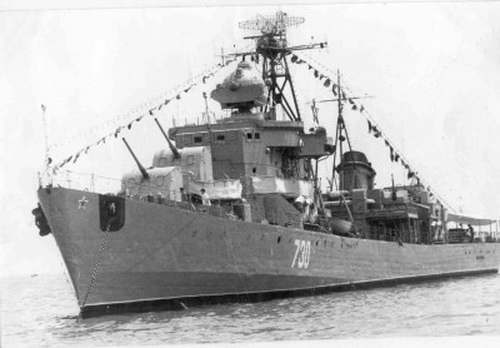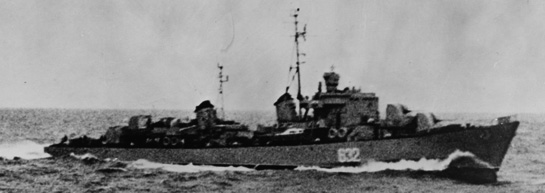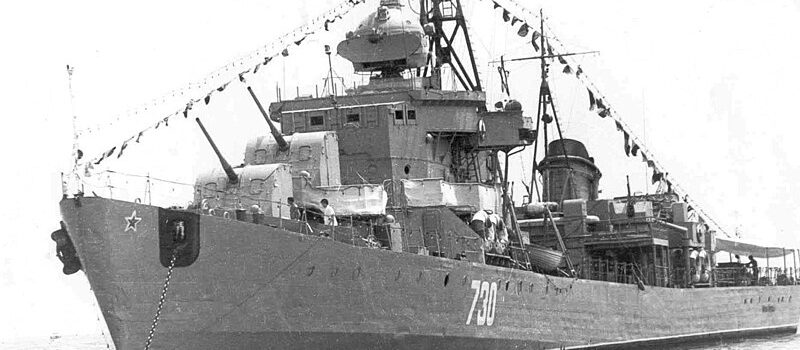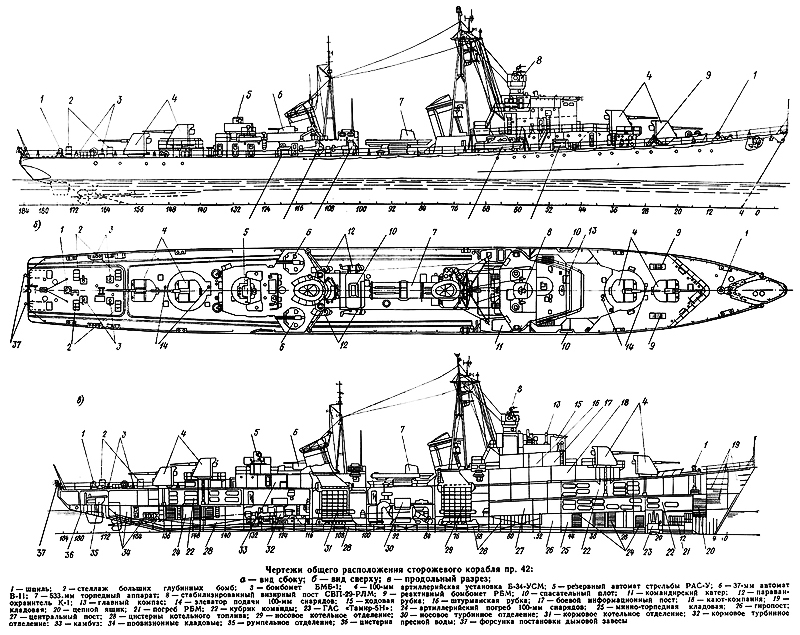 8 General Purpose Frigates 1949-1980
8 General Purpose Frigates 1949-1980
The Kola class frigates were known under this name under NATO reports. These Soviet frigates built postwar received the designation or Storozhevoi Korabl (for “escort ship”) and official Project 42 and Sokol class after the lead ship post-1990 by historians. They were an improved copy of the Kriegsmarine’s World War II destroyer escorts of the Elbing-class, enlarged torpedo boats which were captured and studied after 1945. The programme was cut down to just 8 ships as seen as too expensive for mass production. Instead the much smaller and simpler design of the Riga-class was chosen, showing the path for future Frigates designs in the USSR. Despite their cost, they appeared far more capable than ASW frigates and performed escort missions until the late 1970s and earluy 1980s for some, a remarkable career.
Development

Sokol, a Kola-class frigate
These ships classified as frigates (Strozhevoi Korabl, or light escorts) were in fact very inspired by the German torpedo boats of 1942-44. They were designed in parallel with the destroyer Neustrashimyy, from which they borrowed a number of innovations. The Naval Office conceived them as early as 1943, and the studies leading to their construction continued until their definitive approval in 1947, after the competition, for the first time in Russia since 1917, of two engineering offices, TsKB-32 and 53. Stalin intervened in the preparatory phases, demanding the resumption of the Yastreb as base of work.
They were initially planned for patrolling Soviet waters, escorting convoys, filling a niche that seldom existed. The design process started in 1945 with official specification issued, two design bureau competing, one having diesel engine, the other and steam turbines. Both proposed a flush deck hull, welded and longitudinally framed and whatever the engine type, they were placed in alternating boiler rooms and turbine rooms for better survivability. Armament was reminiscent of the German ww2 design, with four single 100 millimetres (3.9 in) dual purpose guns in superfiring positions fore and aft as well as a torpedo tubes banks, depht charge launchers and racks.
The TsKB-32, the Leningrad design office, won this competition with a steam-powered vessel capable of 30 knots. However, the official requirement was modified for a new type of 100mm now dual purpos, ans added two 37mm AA guns, only one Anti-ship torpedo tube bank with new heavy ASW torpedoes, two ASW rocket launchers, and kept two ASW depth charge launchers and racks, over a maximum displacement of 1,300 tonnes. This limit was quickly deemed impracticable, a new larger design was submitted, and Project 42 was submitted to Stalin, which opposed the program, considering them too expensive and too large. In the end they were not approved for mass construction. Instead the order was rescinded to just 8 ships all built in Kaliningrad. All were in service in 1960. Kondor struck a reef and sank in 1962, and the others remained in service until the 70s-80s.
Design of the Kola class

Kola class frigate profile
The actual standard displacement of the ship (1,339 tons) turned out to be more than the specified technical specifications, but less than what was obtained in the technical design (1,360 tons). The draft of the ship, even with a full displacement (3.36 m), made it possible to navigate many inland waterways of the country (the Caspian Sea became the place of service of some of these TFRs).
The abandonment of the forecastle made it possible to simplify the hull design and increase operational convenience (the presence of a direct passage along the upper deck). Based on the experience of the Great Patriotic War, it was necessary to strengthen the main connections of the corps, which led to a relative increase in the “corps” item in the workload of the masses, but the volume of reinforcements adopted turned out to be insufficient. During the period of running factory and state tests, cracks were discovered in the frame frames and transverse bulkheads in the area of 168-179 shp at the aft end of the ship. They were caused by significant vibration in the area. Elimination of identified damage was carried out by installing additional reinforcements in the area of 145-179 shp., in accordance with the drawings approved by the Central Research Institute named after. Academician A. N. Krylov and the 1st Central Research Institute of Moscow Region.
The ship’s hull was divided into 11 compartments by watertight bulkheads. At the same time, the ship’s unsinkability was ensured when two adjacent compartments were flooded with a standard displacement. With the symmetrical flooding of three adjacent compartments (except for the area 115-171), the ship remained afloat. When two aft compartments were flooded in the area of 134–171 shp. at full displacement, the upper deck did not enter the water.

A Kola-class ship in sea trials in 1952-53
The speed obtained during the tests turned out to be higher than the design one and amounted to 29.65 knots at full speed (at a propeller shaft speed of 580 rpm). Sea trials were carried out in sea conditions of 6 points and winds of 8 – 9 points on March 28, 1951 in the Bay of Gdansk. They showed that up to 24 knots the loss of speed in seas was only 0.5 knots, i.e. significantly less than that of SKR Project 29K and EM Project 30-bis, and the roll was less than on ships of Project 29K m 30 bis. There was practically no flooding, and slight splashing was observed in some cases at heading angles of 45°-50°. When the speed increased to 28 knots, its loss increased to 1 knot. At the same time, at heading angles of 45-90°, the ship was heavily splashed along its entire length, but even in these conditions it was possible to use weapons (the maximum amplitude of roll reached 20°).
Thanks to the presence of two rudders, the ship’s maneuverability turned out to be excellent: the circulation diameter at full speed was only 4.7 ship lengths.
The echelon arrangement of the mechanical installation (with its placement in 4 compartments in the area of 66-134 ships) turned out to be quite convenient and even freer than on previous domestic TFRs and destroyers of all types. Two TV-10 turbo-gear units with a total power of 27,800 hp were used as the main engines. With. in a two-body design. Two main water tube boilers of the triangular type KV-42 with natural circulation provided a total specification steam output of 146 t/h at an operating pressure of 28 kgf/cm2 and a superheated steam temperature of 370 °C. Just like on the EM pr. 30-bns, tests revealed increased high-pitched noise on the ship, created by the operation of turbofans and TZA gearboxes (in the boiler room from 113 to 128 dB, and in the engine room from 104 to 114 in the PES – 85 dB ), characteristic, however, of all post-war domestic ships.
Hull and propulsion:
The end result had grown from 1,300 to 1,340 tins standard and 1,600 tons normal, c1,750 tons fully loaded. The hull length was 96 m (315 ft), for a beam of 10.8 m (35 ft) and a draught of 3.2 m (10 ft). The hull had electric lighting an few portholes fore and aft. The lower bow had a knuckle.
The winning design had steam turbines, only capable of keeping the speed relevant with the additional tonnage and thus, Project 42 ships had two shaft geared steam turbines and 2 boilers, all separated in their own rooms, for a total output of 27,800 hp (20,700 kW) and a top speed of 30 kn (56 km/h; 35 mph), less than the 33 expected.
Range was less stellar than for an hypothetic diesel version, down to 3,300 nmi (6,100 km; 3,800 mi) at 13.7 kn (25.4 km/h; 15.8 mph), which was still acceptable at the time for the distances travelled. They had two raked funnels, a tall bridge, two masts, both tripod and located close to each funnel, the mainmast aft being smaller. The main fire control system was installed on top of the bridge. A smaller AA director was located aft on a platform over the quarterdeck house.
Armament:
Four single 100 mm guns B-34 located fore and aft.
Two twin 37 mm guns V-11M located aft on quartedeck house wings platforms
Two twin 25 mm guns located forward, abadft the bridge on wings (later removed)
Two MBU-900 anti-submarine rocket launchers (later RBU-2500 Smerch ASWRL) located abaft the first turret on deck
Single triple 533 mm torpedo tube bank located between the funnels amidships
48 depth charges, between two racks at the poop and four throwers aft on the sternd deck.
4 Paravanes located close to the aft funnel structure
Mines Rails seen on deck starting aft of the bridge down to the stern, perhaps c100 mines, model unknown.
Sensors (no info available):
-Rif (NATO “Cross Bird”) air warning radar
-Giuys-1MN (NATO “Ball Gun”) surface and navigation radar
-Visla Fire Control radar
-Tamir-5N sonar or Pegas.
-Bizan’ 4 ECM suite
⚙ Kola class specifications |
|
| Displacement | 1900, 2300t FL |
| Dimensions | 96 x 10.8 x 3.2 m |
| Propulsion | 2 shafts, 2 turbines, 2 boilers 17,800 hp |
| Speed | 30 knots (56 km/h; 35 mph) |
| Range | 3,300 nmi (6,100 km; 3,800 mi) at 13.7 kn (25.4 km/h; 15.8 mph) |
| Armament | 4×1 100 mm, 4x 37 mm AA, 2x RBU-900 ASWRL, 2 DCT(12), 4 DCT(36), 1×3 TT 533 mm ASWTTs. |
| Sensors | Cross Bird Radar Electronics, Ball Gun, Pegas sonar |
| Crew | 175-190 |
The artillery armament consisted of four universal B-34-USM installations with a total ammunition capacity of 1080 rounds. (based on the B-34 installation created in the 30s for cruisers of Project 26) and four 37-mm machine guns (5400 rounds) in two twin B-11 installations. To control the fire of universal-caliber artillery systems, the Zenit-42 fire control device system was used. The technical rate of fire of the B-34-USM installations was 15 rds/min (in tests with a low-trained crew – 12 rds/min). The maximum firing range reached 121.6 kb with a live cartridge with an initial projectile speed of 900 m/s. The gyroazimuth horizon (“Component”) provided data output to the control system circuit at a roll of up to 15°.
On the lead ship (due to the unavailability of the standard SVP-42), a temporarily serial SVP-29-RLM with a Vympel-2 radio range finder was installed, which had a number of shortcomings.
The TTA-42 torpedo tube with the Stalingrad-T-42 launcher was designed to fire 53-38, 53-38U and 53-39 torpedoes at surface targets. If in the Great Patriotic War, even domestic destroyers used torpedo weapons only a few times, then the assumption that the TFR would be able to use it in a future war was more than doubtful. Even at the design stage, the ship was equipped with two RBM rocket launchers for the first time. In the combat position, they had an elevation angle of 45° and a firing range of only 260 m, which caused concern among the State Acceptance Commission, which did not rule out that the ship, with a circulation radius of about 2 kb and a short firing range of the RBM, could end up in the zone of explosions of bombs from its own salvo if will go at great speed. The commission considered it expedient to improve the rocket launcher, making it guided according to data from a hydroacoustic station (GAS) and stabilized by the angle of bomb throwing.
The remaining types of weapons and weapons did not receive any special comments from the commission. Thus, the “Reef” radar had a surface target detection range of 110 kb, and a dead zone of 2 kb. The Guys-1M4 air target detection radar detected a tactical bomber at a flight altitude of 3000 m at a distance of 250 kb.
GAS “Tamir-511” made it possible to detect an underwater target at a speed of 10 knots at a distance of 16 kb.
All weapons and weapons could be used without restrictions when the sea state was up to 4 points and with minor restrictions – up to 6 points.
In the final protocol, the State Acceptance Commission of the head SKR pr. 42 “Falcon” noted: “the ship fully meets its operational and tactical purpose; having four CC barrels with a modern launch control system, four 37-mm machine guns in two twin mounts, torpedo and anti-submarine weapons, modern radar and communications equipment, as well as quite satisfactory seaworthiness (for the conditions of the Baltic Sea) … with a good cruising range and habitability, the Sokol SKR compares favorably with the Sokol SKR pr. 29K and technical project 50; the available unspent displacement reserve, in the presence of a stability margin, can ensure, if necessary, the installation of an additional three twin V-11 installations on the ship without significant deterioration in technical characteristics ship. SKR pr. 42, as having quite satisfactory seaworthiness, good wave riding and controllability, as well as a long cruising range, can be successfully used in the Northern and Far Eastern maritime theaters.”
Despite the positive results obtained during the tests, SKR Project 42 were built in a limited series of ships at plant No. 820 (Table 2), which entered service in 1951-1953. There are many reasons for the refusal of large-scale construction of these ships, and first of all the decision of the Chairman of the Council of Ministers of the USSR I.V. Stalin. Unfortunately, many decisions and various reasons for their adoption never found documentary expression and remained only in the fragmentary memories of the leaders of those years. It can be assumed that the continued evolution of views on ships of this class on the part of the highest military and political leadership did not give a clear answer to the question “What convoys were supposed to guard these ships?” While the development of the USSR economy in the post-war years was again focused on “all-round defense from the imperialists and complete autonomy of the state,” ships of smaller displacement were required for patrol service and protection of small coastal convoys.
 Sokol
Sokol
Сокол (“Falcon”) was laid down at 820 Yd, Kaliningrad like all others, on 17.8.1949, launched 11.9.1950, commissioned in 4.12.1952, transferred to the Caspian Sea, training hulk august 1971 and scrapped in the 1970s.
 Berkut
Berkut
Беркут (“Golden Eagle”) was laid down on 25.4.1950, launched 2.4.1951, completed 10.5.1952, Scrapped in the 1970s after being a training ship from 1965.
 Kondor
Kondor
Кондор (“Condor”) was laid down on 28.6.1950, launched on 27.5.1951, completed on 10.5.1952, but lost after being grounded, wrecked near Murmansk 1962. She was impossible to tow her off, so she was blasted and the remnants gradually scrapped. She was stricken in January 1970.
 Grif
Grif
The Гриф (“Vulture”) was laid down on 18.9.1950, launched on 3.9.1951 and completed on 25.10.1952. She was assigned to the Border Guard (GRIF border guard ships, project 42, 1952) from 12.1953, transferred to the Caspian Sea, and became an accommodation hulk 12.1977, fate unknown probably scrapped 1980s.
 Krechet
Krechet
Кречет (“Gyrfalcon”) was laid down on 15.12.1950, launched on 27.11.1951 and completed on 18.12.1952, she became a Border Guard until 12.1953, was stricken in june 1977, scrapped.
 Orlan
Orlan
Орлан (“Sea Eagle”) was laid down on 30.4.1951, launched on 9.5.1952 and commissioned on 17.3.1953. She was transferred to the Caspian Sea as guard ship at a later date, stricken 11.1976.
 Lev
Lev
Лев (“Lion”) was laid down on 30.4.1951, launched 24.5.1952 and commissioned on 17.3.1953. She became a training hulk by August 1971, stricken and scrapped in the early 1980s
 Tigr
Tigr
Тигр (“Tiger”) was laid down on 1.7.1952, launched on 29.9.1952 and commissioned on 25.4.1953. She was stricken in September 1974.
Read More/Src
Gardiner, Robert; Chumbley, Stephen & Budzbon, Przemysław (1995). Conway’s All the World’s Fighting Ships 1947-1995. NIP
russianships.info/ project_42.htm
politinform.su korabli-tipa-sokol-proekta-42-kola-class
http://www.atrinaflot.narod.ru/
http://www.navycollection.narod.ru/ships/Russia/Frigates/SKR_Proect_42/history.html
on ru.wikipedia.org
navypedia.org/ soviet escorts
navypedia.org sokol class



 Latest Facebook Entry -
Latest Facebook Entry -  X(Tweeter) Naval Encyclopedia's deck archive
X(Tweeter) Naval Encyclopedia's deck archive Instagram (@navalencyc)
Instagram (@navalencyc)





 French Navy
French Navy Royal Navy
Royal Navy Russian Navy
Russian Navy Armada Espanola
Armada Espanola Austrian Navy
Austrian Navy K.u.K. Kriegsmarine
K.u.K. Kriegsmarine Dansk Marine
Dansk Marine Nautiko Hellenon
Nautiko Hellenon Koninklije Marine 1870
Koninklije Marine 1870 Marinha do Brasil
Marinha do Brasil Osmanlı Donanması
Osmanlı Donanması Marina Do Peru
Marina Do Peru Marinha do Portugal
Marinha do Portugal Regia Marina 1870
Regia Marina 1870 Nihhon Kaigun 1870
Nihhon Kaigun 1870 Preußische Marine 1870
Preußische Marine 1870 Russkiy Flot 1870
Russkiy Flot 1870 Svenska marinen
Svenska marinen Søværnet
Søværnet Union Navy
Union Navy Confederate Navy
Confederate Navy Armada de Argentina
Armada de Argentina Imperial Chinese Navy
Imperial Chinese Navy Marinha do Portugal
Marinha do Portugal Mexico
Mexico Kaiserliche Marine
Kaiserliche Marine 1898 US Navy
1898 US Navy Sovietskiy Flot
Sovietskiy Flot Royal Canadian Navy
Royal Canadian Navy Royal Australian Navy
Royal Australian Navy RNZN Fleet
RNZN Fleet Chinese Navy 1937
Chinese Navy 1937 Kriegsmarine
Kriegsmarine Chilean Navy
Chilean Navy Danish Navy
Danish Navy Finnish Navy
Finnish Navy Hellenic Navy
Hellenic Navy Polish Navy
Polish Navy Romanian Navy
Romanian Navy Turkish Navy
Turkish Navy Royal Yugoslav Navy
Royal Yugoslav Navy Royal Thai Navy
Royal Thai Navy Minor Navies
Minor Navies Albania
Albania Austria
Austria Belgium
Belgium Columbia
Columbia Costa Rica
Costa Rica Cuba
Cuba Czechoslovakia
Czechoslovakia Dominican Republic
Dominican Republic Haiti
Haiti Hungary
Hungary Honduras
Honduras Estonia
Estonia Iceland
Iceland Eire
Eire Equador
Equador Iran
Iran Iraq
Iraq Latvia
Latvia Liberia
Liberia Lithuania
Lithuania Mandchukuo
Mandchukuo Morocco
Morocco Nicaragua
Nicaragua Persia
Persia San Salvador
San Salvador Sarawak
Sarawak Uruguay
Uruguay Venezuela
Venezuela Zanzibar
Zanzibar Warsaw Pact Navies
Warsaw Pact Navies Bulgaria
Bulgaria Hungary
Hungary

 Bundesmarine
Bundesmarine Dutch Navy
Dutch Navy Hellenic Navy
Hellenic Navy Marina Militare
Marina Militare Yugoslav Navy
Yugoslav Navy Chinese Navy
Chinese Navy Indian Navy
Indian Navy Indonesian Navy
Indonesian Navy JMSDF
JMSDF North Korean Navy
North Korean Navy Pakistani Navy
Pakistani Navy Philippines Navy
Philippines Navy ROKN
ROKN Rep. of Singapore Navy
Rep. of Singapore Navy Taiwanese Navy
Taiwanese Navy IDF Navy
IDF Navy Saudi Navy
Saudi Navy Royal New Zealand Navy
Royal New Zealand Navy Egyptian Navy
Egyptian Navy South African Navy
South African Navy






























 Ukrainian Navy
Ukrainian Navy dbodesign
dbodesign